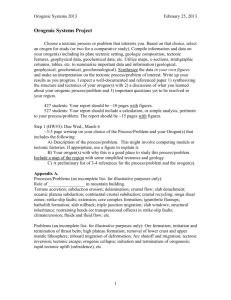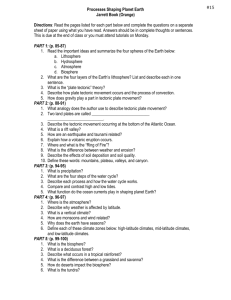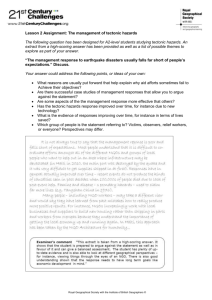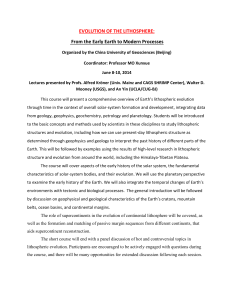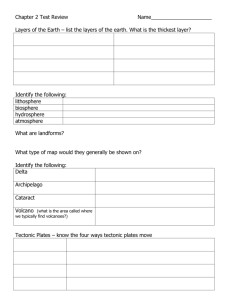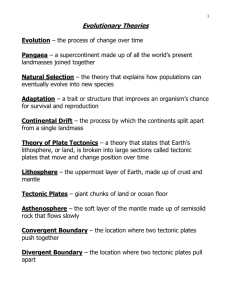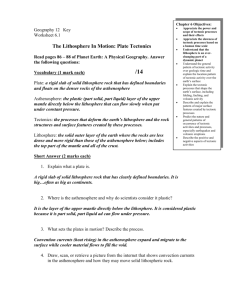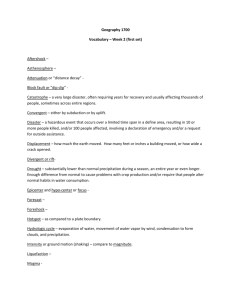由中国国际前寒武研究中心(IPRCC)和“深部探测技术与实验研究”专项
advertisement
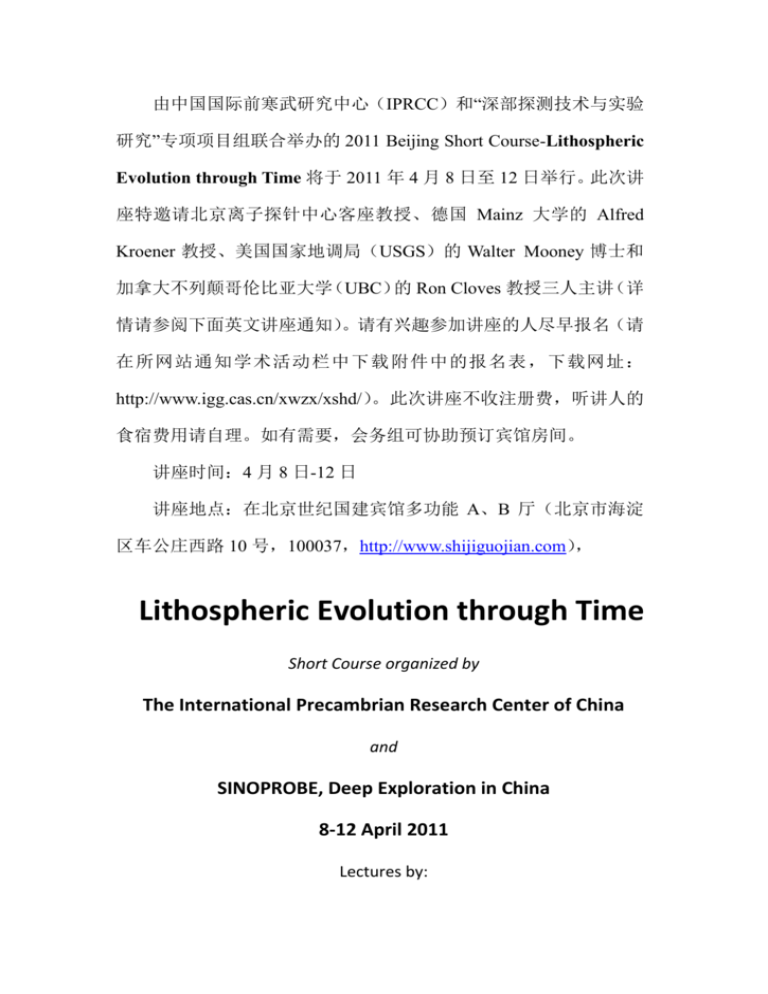
由中国国际前寒武研究中心(IPRCC)和“深部探测技术与实验 研究”专项项目组联合举办的 2011 Beijing Short Course-Lithospheric Evolution through Time 将于 2011 年 4 月 8 日至 12 日举行。此次讲 座特邀请北京离子探针中心客座教授、德国 Mainz 大学的 Alfred Kroener 教授、美国国家地调局(USGS)的 Walter Mooney 博士和 加拿大不列颠哥伦比亚大学(UBC)的 Ron Cloves 教授三人主讲(详 情请参阅下面英文讲座通知) 。请有兴趣参加讲座的人尽早报名(请 在所网站通知学术活动栏中下载 附件中的报名表,下载网址: http://www.igg.cas.cn/xwzx/xshd/)。此次讲座不收注册费,听讲人的 食宿费用请自理。如有需要,会务组可协助预订宾馆房间。 讲座时间:4 月 8 日-12 日 讲座地点:在北京世纪国建宾馆多功能 A、B 厅(北京市海淀 区车公庄西路 10 号,100037,http://www.shijiguojian.com), Lithospheric Evolution through Time Short Course organized by The International Precambrian Research Center of China and SINOPROBE, Deep Exploration in China 8‐12 April 2011 Lectures by: Prof. Alfred Kröner (University of Mainz, Germany, and Beijing SHRIMP Center), Dr. Walter Mooney (United States Geological Survey, Menlo Park, California, USA) Prof. Ron Clowes (University of British Columbia, Vancouver, BC, Canada) Course Outline Day 1, Kröner & Mooney): Introduction: What is the lithosphere? Definitions of the lithosphere and methods used in understanding lithospheric evolution. Geophysical versus geological definitions of lithosphere; composition and layers within the lithosphere; new insights from seismic tomography, magnetic properties, heat flow, paleomagnetism, isotope geochemistry, geochronology and petrology. Early Earth formation (Hadean and Archean): Hot or cold beginning? The first crust, the oldest rocks, formation of continental crust; the first continents. Thermal history of the Earth: mantle convection, early Earth plumes? Archean terranes; subduction and accretion, stabilization of Archean cratons. Day 2, Kröner & Mooney): Geological and geophysical models of the evolution of cratonic lithosphere. The Paleoproterozoic Era and the formation of supercontinents. The Mesoproterozoic Era and evidence for the supercontinent Rodinia. Geology of Africa and other ancient continents. General discussion of first two day’s topics. What are the major disagreements and the best approaches for future research? Day 3, Kröner & Mooney): Orogenic belts ‐ old and young. Phanerozoic accretionary belts: structure, tectonic erosion, evolution. Introduction to a modern orogen: The South American Andes and their deep structure. Outstanding questions and debates in Earth evolution: When did plate tectonics begin? Rates of crustal growth through time; comparison of modern ancient orogens; additional topics. Day 4, Clowes): Brief Seismic Tutorial including 4 short videos (seismic reflection acquisition, RefTek deployment, explosion shot, and offshore‐onshore refraction). Lessons from the Canadian LITHOPROBE project: Development and benefits of a multidisciplinary Earth science megaproject. Geology, geophysics and tectonic evolution of the Archean Slave craton and Paleoproterozoic Wopmay Orogen, northwest Canada. Geology, geophysics and tectonic evolution of the Archean Superior craton, central Canada. Paleoproterozoic crustal evolution and tectonic processes: Insights from the Trans‐Hudson orogen, central Canada. An attempt to split North America – The Mesoproterozoic Mid‐continent Rift. Questions and discussion. Day 5, Clowes): The Mesoproterozoic Grenville orogen ‐‐ Accretion and continental collision on SE Laurentia. Lithospheric architecture and tectonic evolution of the Paleozoic Canadian Appalachians. Structure and tectonic evolution of the Mesozoic‐Recent Canadian Cordillera. Mantle heterogeneities and their significance ‐‐ Results from Lithoprobe seismic reflection and refraction/wide‐angle reflection studies. The big picture: A lithospheric cross‐section of the North American continent. Questions and discussion. End of course. Lithospheric Evolution through Time Organized by: International Precambrian Research Center of China; Sinoprobe,deep exploration in China; Beijing Draft Course Outline (March 16, 2011) Lectures presented by Walter Mooney, Alfred Kröner and Ron Clowes Day 1 (April 8th,2011) 08.30 – 09.00 K+M: Introduction: Purpose, scope and structure of course 09.00 – 10.30 K+M: Some definitions and methods used in understanding crustal evolution (geophysical and geological definition of lithosphere, components of the lithosphere, layering in the lithosphere and how to recognize it; seismology incl. seismic tomography, magnetic properties, heat flow, paleomagnetism, isotope geochemistry, petrology, etc.) 10.30 - 10.45 Break 10.45 - 11.45 Kröner: Early Earth formation (Hadean): Magma ocean, hot or cold beginning? The first crust, the oldest rocks, crust formation: juvenile vs. reworking, the first continents. 11.45 – 12.00 K+M - Questions and Discussion. Video: The early Earth 12.00 – 13.30 Lunch 13.30 – 14.30 Mooney: Geophysical and modeling constraints on lithospheric structure and composition, geophysical images of the oldest crust. 14.30 – 14.45 Break 14.45 - 15.45 Mooney: Thermal history of the Earth (Sleep, Korenaga, etc.), plate motion rates: a debate, mantle convection: early Earth plumes? 15.45 - 17.00 Kröner: Archean gneiss-granite greenstone terranes with examples from southern Africa and western Australia. Early plate tectonics and/or plume tectonics? Formation and deformation of TTGs, Archean subduction and accretion in the Superior Province of Canada, stabilization of Archean cratons. 17.00 - 18.00 K+M: Question time and general discussion on the day’s topics and important literature: Where are the major disagreements and what are the best approaches for future studies? Day 2 (April 9th,2011) 08.30 - 10.15 Mooney: Geophysical models of cratonic lithosphere, Canadian cratons (Lithoprobe), Kaapvaal, Western Australia 10.15 – 10.30 Break 10.30 – 11.45 Kröner: Cratonic cover rocks: Witwatersrand, Pongola, Fortescue, the Palaeoproterozoic and speculations on the supercontinent Nuna or Columbia, palaeomagnetic evidence. 11.45 – 12.00 Questions and discussion 12.00 – 13.30 Lunch 13.30 – 14.30 Mooney: Geology, Structure and Rifting in East Afrcia 14.30 – 15.15 Kröner: The Mesoproterozoic and evidence for the supercontinent Rodinia 15.15 – 15.30 Break 15.30 – 16.30 K+M: Implications for evolutionary models 16.30 – 17.00 Questions and discussion 17.00 – 17.30 Geology video to be announced 18.00 – 19.30 Group dinner Day 3 (April 10th,2011) 08.30 - 10.15 Kröner: Orogenic belts: Old and young, high-grade Limpopo mobile belt, Palaeoproterozoic collisional orogens and first ophiolites, Arabian-Nubian shield as an example for a long-lived Neoproterozoic accretionary orogen, amalgamation of the Gondwana supercontinent. 10.15 – 10.30 Break 10.30 – 11.45 K+M: Phanerozoic accretionary belts, structure, tectonic erosion, etc., Central Asia, Japan, Alaska, Western Pacific, collisional belts: Alps, Caledonides 11.45 – 12.00 Questions and Discussion 12.00 – 13.30 Lunch 13.30 – 14.45 Mooney: Introduction to a modern orogen: The South American Andes and their deep structure 14.45 – 15.00 Break 15.00 – 17:00 K+M: Outstanding questions and debates in Earth evolution: Cratonization and decratonization, supercontinents, when did plate tectonics begin, rates of crustal growth through time, vertical growth via underplating, comparison of a modern orogen (Andes) with ancient orogens. Day 4 (April 11th,2011) 08.30 - 09.00 Clowes: Brief Seismic Tutorial, which includes 4 short (1 to 1.5 minutes each) videos (seismic reflection acquisition, RefTek deployment, explosion shot, and offshore-onshore refraction) 09.00 - 10.00 Clowes: Lessons from the Canadian LITHOPROBE project: Development and benefits of a multidisciplinary Earth science megaproject 10.00– 10.20 Break 10.20 – 11.20 Clowes: Geology, geophysics and tectonic evolution of the Archean Slave craton and Paleoproterozoic Wopmay Orogen, northwest Canada 11.20 – 12.00 Questions and discussion 12.00 – 13.30 Lunch 13.30 – 14.30 Clowes: Geology, geophysics and tectonic evolution of the Archean Superior craton, central Canada 14.30 – 15.00 Clowes: Paleoproterozoic crustal evolution and tectonic processes: Insights from the Trans-Hudson orogen, central Canada (part 1) 15.00 – 15.20 Break 15.20 – 15.50 Clowes: Paleoproterozoic crustal evolution and tectonic processes: Insights from the Trans-Hudson orogen, central Canada (part 2) 15.50 – 16.20 Clowes: An attempt to split North America – The Mesoproterozoic Mid-continent Rift 16.20 – 17.20 Questions and discussion 18.00 – 19.30 Group dinner Day 5 (April 12th,2011) 08.30 – 09.30 Clowes: The Mesoproterozoic Grenville orogen -- Accretion and continental collision on SE Laurentia 09.30 – 10.00 Clowes: Lithospheric architecture and tectonic evolution of the Paleozoic Canadian Appalachians (Part 1) 10.00 – 10.20 Break 10.20 – 10.50 Clowes: Lithospheric architecture and tectonic evolution of the Paleozoic Canadian Appalachians (Part 2) 10.50 – 11.30 Questions and Discussion 11.30 – 12.00 Clowes: Structure and tectonic evolution of the Mesozoic-Recent Canadian Cordillera (part 1) 12.00 – 13.30 Lunch 13.30 – 14.00 Clowes: Structure and tectonic evolution of the Mesozoic-Recent Canadian Cordillera (part 2) 14.00 – 15.00 Clowes: Mantle heterogeneities and their significance -- Results from Lithoprobe seismic reflection and refraction/wide-angle reflection studies 15.00 – 15:30 Clowes: The big picture: A lithospheric cross-section of the North American continent 15.30 – 15.45 Break 15.45 – 16:30 Questions and Discussion The International Precambrian Research Center of China (IPRCC) SINOPROBE, deep exploration in China Lithospheric Evolution through Time Training Course (8-12 April 2011) Registration Form 参会情况 姓名 性别 单位及通讯地址 职务/职称 手机/座机 电邮 Part One: 8-10 日 Part 2: 11-12 日 (免注册费) (免注册费) 备注: 1. 报名表可根据需要添加多行; 2. 讲座的地点设在北京世纪国建宾馆多功能 A、B 厅(北京市海淀区车公庄西路 10 号,100037,http://www.shijiguojian.com); 3. 讲座免注册费,参会人的差旅及食宿费用等请自理; 4. 因讲座分为两个部分,共 5 天时间,请在报名表“参会情况”栏下方的空格中勾出您打算参加的讲座部分; 5. 如有其它问题,请与会务组联系,Email:zhouqigsc@yahoo.com.cn(周琦),zirconworkshop2010@126.com(王晨)。
